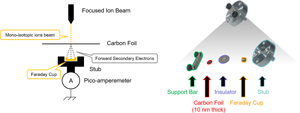Published online by Cambridge University Press: 20 September 2021

A position and energy-sensitive detector has been developed for atom probe tomography (APT) instruments in order to deal with some mass peak overlap issues encountered in APT experiments. Through this new type of detector, quantitative and qualitative improvements could be considered for critical materials with mass peak overlaps, such as nitrogen and silicon in TiSiN systems, or titanium and carbon in cemented carbide materials. This new detector is based on a thin carbon foil positioned on the front panel of a conventional MCP-DLD detector. According to several studies, it has been demonstrated that the impact of ions on thin carbon foils has the effect of generating a number of transmitted and reflected secondary electrons. The number generated mainly depends on both the kinetic energy and the mass of incident particles. Despite the fact that this phenomenon is well known and has been widely discussed for decades, no studies have been performed to date for using it as a means to discriminate particles energy. Therefore, this study introduces the first experiments on a potential new generation of APT detectors that would be able to resolve mass peak overlaps through the energy-sensitivity of thin carbon foils.